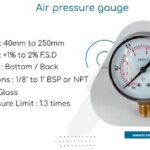How Does an Air Pressure Gauge Work?
How Does an Air Pressure Gauge Work?
Introduction
An air pressure gauge is a tool used in a variety of settings, including as homes, cars, and industries, to measure the pressure of gases, mostly air. These gauges offer vital information to guarantee the effectiveness and safety of systems that depend on pressured air, including HVAC systems, air compressors, and pneumatic tools. Selecting the appropriate type for various purposes and guaranteeing appropriate maintenance can be made easier with an understanding of how an air pressure gauge operates.
An air pressure gauge is an essential instrument used in various industries to measure the pressure of air or gas in a system. These gauges play a crucial role in ensuring safety, efficiency, and optimal operation of machinery, pneumatic tools, and even automotive tires. Understanding how an air pressure gauge works involves exploring its components, principles of operation, and different types available on the market.
Basic Principle of Air Pressure Measurement
Pascal’s Law, which asserts that pressure supplied to a confined fluid is transferred undiminished throughout the fluid, is the primary physics principle upon which an air pressure gauge operates. The most common units of measurement for air pressure gauges are pounds per square inch (PSI), bar, or kilopascal (kPa).
Although there are many different kinds of air pressure gauges, the majority work by translating the force that air pressure exerts into a mechanical or digital output that can be read.
Types of Air Pressure Gauges and Their Working Mechanisms
1. Bourdon Tube Pressure Gauge
One of the most commonly used air pressure gauges is the Bourdon tube gauge. It consists of a curved, hollow metal tube that deforms when subjected to air pressure.
Working Principle:
-
When air pressure enters the tube, it straightens slightly due to the force exerted by the air.
-
The movement of the tube is transferred through a mechanical linkage to a pointer on the gauge dial.
-
As the pressure increases or decreases, the pointer moves accordingly, providing a direct reading of air pressure.
This type of gauge is widely used in industrial settings and air compressors due to its durability and accuracy.
2. Diaphragm Pressure Gauge
A diaphragm pressure gauge utilizes a flexible diaphragm that moves in response to air pressure.
Working Principle:
-
The diaphragm is enclosed within a chamber and is exposed to air pressure on one side.
-
As the air pressure changes, the diaphragm flexes inward or outward.
-
This movement is then transferred to a mechanical or electronic system that translates it into a readable pressure value.
Diaphragm gauges are commonly used in low-pressure applications and environments where pressure fluctuations are frequent.
3. Digital Pressure Gauge
A digital air pressure gauge uses electronic sensors to measure pressure and display the reading on a digital screen.
Working Principle:
-
A pressure sensor (such as a piezoelectric or strain gauge sensor) detects the force exerted by the air pressure.
-
The sensor converts the mechanical pressure into an electrical signal.
-
The signal is processed by a microcontroller, which then displays the pressure value on an LCD or LED screen.
Digital gauges are highly precise and are preferred in applications requiring detailed pressure monitoring and data logging.
4. Differential Pressure Gauge
A differential pressure gauge measures the difference between two air pressures.
Working Principle:
-
The gauge consists of two separate chambers, each connected to a different air source.
-
The pressure difference between the two chambers moves a diaphragm or piston.
-
The movement is translated into a readable pressure value on the gauge dial.
These gauges are essential in HVAC systems, filter monitoring, and process control applications.
Applications of Air Pressure Gauges
Air pressure gauges are used in various fields, including:
-
Automotive Industry: To measure tire pressure, ensuring proper inflation for fuel efficiency and safety.
-
Industrial Applications: In air compressors and pneumatic tools to monitor operating pressures.
-
HVAC Systems: To regulate and monitor air pressure in ventilation systems.
-
Medical Field: In devices like ventilators and anesthesia machines to control air pressure.
-
Aerospace and Aviation: In aircraft systems where precise air pressure readings are crucial.
How to Read an Air Pressure Gauge
Reading an air pressure gauge depends on its type:
-
Analog Gauges: Check the needle position on the dial, ensuring it aligns with the correct unit of measurement (PSI, bar, kPa).
-
Digital Gauges: Simply read the value displayed on the screen.
-
Differential Gauges: Compare the two pressure readings to assess system performance.
Maintenance and Calibration
To ensure accurate readings and longevity, air pressure gauges require regular maintenance and calibration:
-
Inspection: Check for signs of wear, leaks, or damage.
-
Cleaning: Remove dust and debris from the gauge face and sensor ports.
-
Calibration: Compare the gauge’s reading with a known reference standard and adjust if necessary.
-
Replacement: If a gauge is consistently inaccurate or damaged, replacing it is the best option.
Conclusion
For measuring and tracking air pressure in a variety of systems, air pressure gauges are essential instruments. Depending on the kind, they operate differently; the most popular types are digital, differential, diaphragm, and Bourdon tube pressure gauges. Their accuracy and dependability are ensured by proper use, routine maintenance, and calibration, which enhances the effectiveness and security of compressed air and pneumatic systems.
- India


Leave Your Comment